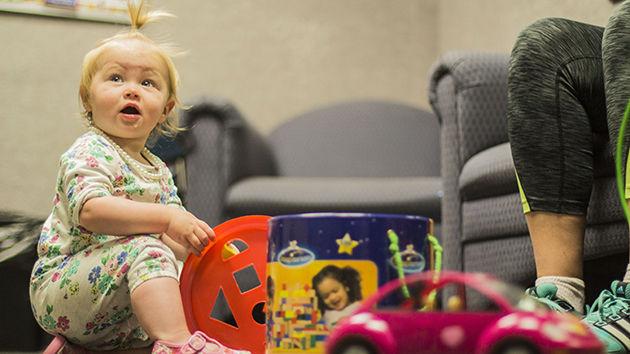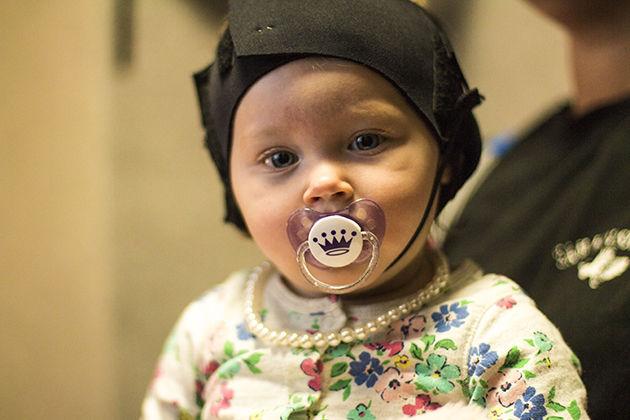Puppet shows, cartoon ducks and animated stars are some of the tools used in the Infant Cognition Lab to test brain development among babies.
In an effort to analyze knowledge development, infants who are 3 to 18-months old are tested in the Infant Cognition Lab at A&M to check for their ability to recognize differences in objects and shapes based on eye movement. Based on where the subjects’ eyes move and focus, researchers can gather information on infant cognitive development. Teresa Wilcox, professor of psychology and director of the program, has been conducting these tests at Texas A&M since 2000.
“Babies can’t tell us what they’re thinking, so we can’t ask them,” Wilcox said. “We have to use other methods.”
Wilcox said the infants are mainly tested by analyzing what aspects of an image they focus on.
“One of the things we use is eye tracking that can tell us exactly where babies are looking on the display,” Wilcox said. “For instance if we show a face, we can tell whether the baby is looking at they eyes or the mouth and that gives us information on where they’re looking and how they process it.”
Ruby Gammon, a 12-month old subject, was tested using both eye-tracking and a headband that reads brain activity. The headbands the Infant Cognition Lab uses are made in-house by the staff. The headbands shine infrared light on the infant’s head and reflect it into a receptor to track brain activity harmlessly. The lights can detect change in blood flow and tell what parts of the brain are active.
During the test Gammon was shown a series of images of stars in the shape of 3-D objects such as cubes and cylinders. Two student workers, psychology senior Sydney Holmes and psychology and sociology senior Lynee Hererra, observed the test behind a curtain, making notes of the infant’s responses.
“Babies are really good at [recognizing] 2-Dimensional objects, but they’re not as good at tracking 3-Dimensional objects. On the screen we’re paying attention to where she’s looking and how long she’s looking,” Herrera said. “So we’re looking at what part of a shape babies are looking at to determine if they’re rotating — like whether they’re looking at corners, edges or faces.”
Another test analyzed infants’ response to being shown a rolling tool and a pizza cutter side-by-side in a video. Holmes said this test is done to see if infants can tell the difference between similar objects with different functions.
“We’re seeing how babies develop these categories for learning the relationships between objects by learning the functions of the objects,” Holmes said. “Then we give them a disclusion test. We’re expecting that even though these objects look similar, they perform different functions, so they can tell the difference.”
Other tests are run in the form of a puppet show, in which a puppeteer manipulates objects from one side of a curtain while two other testers observe the infants’ reactions from afar.
“The puppet stage will tell us overall whether babies are more interested in some events than others or whether they’re more surprised by some events than others,” Wilcox said. “The eye tracking tells us exactly what part of the object they’re looking at, and how long they’re looking.”
The observations and discoveries of the Infant Cognition Lab are brought to conferences during the year to share with other child-development specialists.
One such finding is that the infants react better to the motion of human hands rather than mechanical hands.
Marisa Biondi, fourth year psychology graduate student and Infant Cognition Lab worker, said the sharing of these observations and others give valuable information that goes toward child education development.
“It has implications on the rest of their development and education,” Biondi said. “If someone was doing research on the autism spectrum for instance, other researchers could take what we’ve developed and use it for infants who are developing atypically.”
Wilcox said although it’s harder to keep the attention of infants, they make better subjects than adults.
“I much prefer testing babies over adults,” Wilcox said. “Babies are much cuter. It’s very worthwhile.”
Small research subjects, big impacts
March 23, 2016
Photo by Photo by: Alexis Will
Puppet shows, cartoon ducks and animated stars are some of the tools used in the Infant Cognition Lab to test brain development among babies.
Donate to The Battalion
Your donation will support the student journalists of Texas A&M University - College Station. Your contribution will allow us to purchase equipment and cover our annual website hosting costs.





















